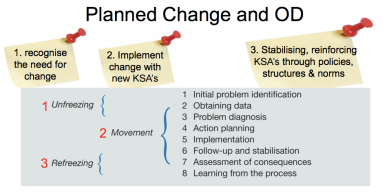Change is nothing new and a simple fact of life. Mullins mentioned that there is little management can do about resistance to change. In my point of view it is not right. New ideas and new technologies change our daily life and working situation all the time. It is a pervasive influence and an inescapable part of organisation and management still can do many things to overcome resistance to change.
Change always be seen as a problem. The first thing that manager need to know for overcome resistance of change is finger out why individual and organisation resist change. As a human being, people don’t like change. Despite the new opportunities and positive results may come from change some individuals and organisations still prefer staying in their comfort zone and resistance to change. It is a normal phenomenon. Resistance show up because change do not enough accept or experience the necessity.
The reason why both individuals and organisations resistance of change is hard to be identified. Mullin (2013:717-7) presented some common reasons that individuals resistance to change within organisations are from selective perception, habit, inconvenience or loss of freedom, economic implications, security in the past, and fear of the unknown. For example, in my personal experience, studying abroad is a change for me and I was resist in this change because the fear of the unknown. And organisational resistance of change arise from organisational culture, investment in resources, maintaining stability, threats to power of influence and past contracts or agreements.
Resistance of change can lead to a lack of support of people within organisation. Change can affects the all operational aspects of the organisation. In order to survive and success, organisation have to positively adapt and response to change.Leader within organisation is able to implement change. Manager within organisation have to guide those people who resistance of change to develop their organisation. Manager must be clear understand the role of culture, the drives and types of change, the sequential phase of change and how to diagnose and approach organisational problems.
Change is driven by many forces. Manager need to understand forces that drive change. Globalisation makes changes faster than ever before. There are many drivers of change such as:
1. Uncertain economic conditions
2. Government intervention and political interests
3. Outsourcing and the redefinition of core business
4. Increased demand for high quality goods, services and customer satisfaction
5. Fragmentation and distribution of work across people, organisations and locations
6. Changing demographics and expectations of workforce
7. Advances in technology
8. Increasing pace, scale and complexity of organisational change
According to those above forces, manager can lead their people to diagnose the impact of change. Based on those change drivers manager can implement four types of organisational change to response the external and internal changes, such as structure, people, technology and organisational development (OD). The organisational development refers to techniques or programs to change people and the nature and quality of interpersonal work relationships. It is also about planned change, that is getting individuals, teams and organisations to function better (French & Bell, 1995).
Lockhead maintains that the most successful organisations develop a culture that welcome change and bring new opportunities for itself. Manager can encourage people have positive attitude to the new challenges and constant change. Organisation can create a planned change for their organisation development to overcome resistance of change. Planned change can be divided into three process, such as unfreezing, movement and refreezing.
Those processes guide managers how to action on change. Unfreezing is the first process to implement change. It refers to reduce the forces of change which present form of behaviour, recognition of the needs for change and improvement to occur for response to those change drivers. The second process is movement. In this process, new KSA (Knowledge, Skill and Attitude) be developed to implement change. The third process is refreezing. It stabilising, reinforcing knowledges, skills and attitudes through supporting mechanisms, for example structure, policy and norm.
The author strongly recommend managers use The McKinsey 7S Model and through change the elements within this model to reduce resistance of change. Those 7S elements are Shared Values, Systems, Strategy, Structure, Style, Staff and Skills.
One of those elements change could affects all the others. For example, if an organisation wants to change Strategy for managing culture change, they can create new stories, symbols and rituals to replace the current one.
In conclusion, no matter how this world change, there are still could use different approaches to across to the change. The most important is control the resistance emotion of change to maintain or development organisational position in the market.
References


It is very good development my understanding about change and change management
LikeLike
Thank for your common, i hope is meaningful for you.
LikeLike
I do resistance of change as well, everything different make me nervous
LikeLike
Don’t Worry. your will adapt and past the change
LikeLike
This blog inspire me how to change to development organisation
LikeLike
Hope you like it, thank you.
LikeLike
the blog make me know why change happened in the organization , i like it
LikeLike
Thanks for your support :), I will leave common on your blog as well.
LikeLike
Excellent writing and inspiring, enjoyed the read. ❤
LikeLike
Thank you~
LikeLike
I’m reblogging this for sure!
LikeLike
Thanks for the info; it’s well worth archiving.
LikeLike
Thanks for your reading and support!
LikeLike